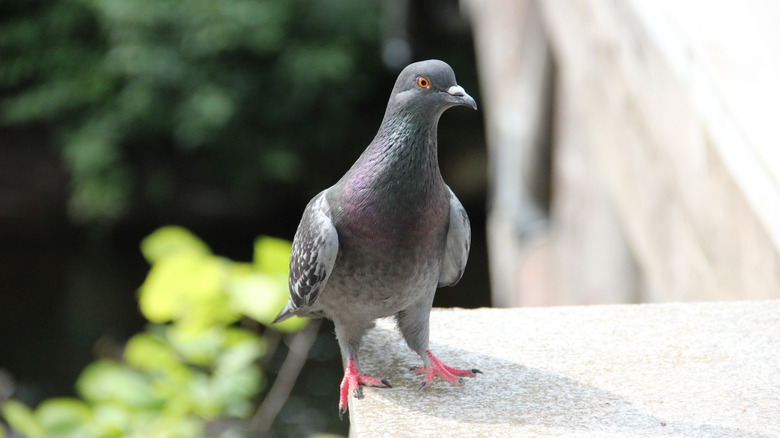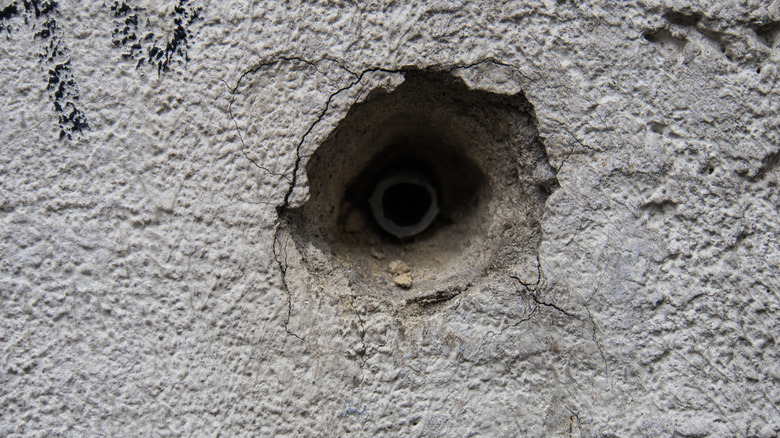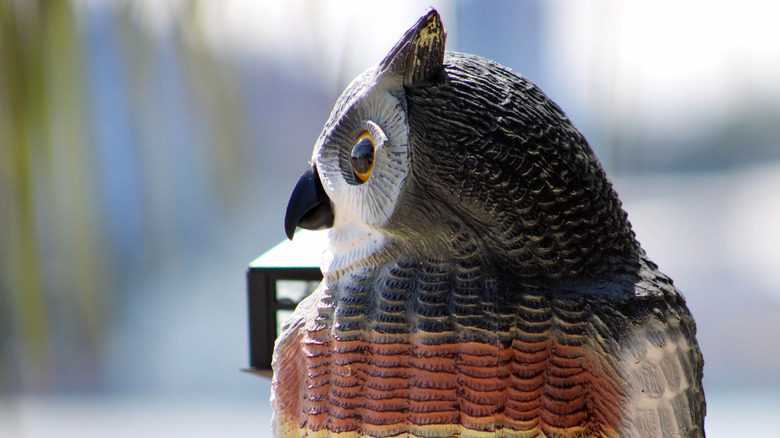10 Ways To Stop Birds Nesting Where You Don't Want Them
We may receive a commission on purchases made from links.
Birds are beautiful and interesting creatures, and many people enjoy observing them. However, no matter how much you like watching birds from afar, you probably won't want them building nests in your gutters, in your chimney, or in any of your home's crevices. Unfortunately, though, birds are often drawn to these areas, which can present a real problem for homeowners.
Bird nests can become obstructions, create fire hazards, and make you susceptible to health issues that come from inhaling spores from bird waste. Luckily, there are quite a few things you can do to keep birds away from nesting where you don't want them. Ready to find out how? Keep reading to learn about 10 ways to stop birds nesting in unwanted areas.
Please note that these methods should only be used to prevent birds from nesting. They should not be used as a way to remove live nests. The Migratory Bird Treaty Act (MBTA) makes it illegal to remove active bird nests, except when permits are granted under very rare circumstances.
Install mesh netting over eaves and rafters
The eaves and rafters of your home can be an attractive place for birds who are looking to build a nest. While those spots may feel like home sweet home for birds, nesting in these areas can also cause serious problems for homeowners. Bird nests on eaves and/or rafters can create a fire hazard due to the flammable nature of the nesting materials (dried sticks, plants, etc.). In addition, bird droppings can damage the paint and metal on your home.
Fortunately, installing mesh netting is a fairly easy and inexpensive solution to this problem. Place the netting over your eaves/rafters at a 45-degree angle. Experts suggest using ¼ to ½-inch netting for the most effective results, such as Comfality's bird guard, which comes with fasteners to keep the netting secured. If you don't have fasteners, you can secure your netting with staples or heavy-duty tape. Keep in mind that you need to ensure that the netting is properly fitted to avoid gaps.
Cap your chimney
Birds taking permanent residence in your chimney may feel like a minor nuisance, but the reality is that their nests can pose serious issues for your home. Bird nests in chimneys can block airflow, resulting in fire hazards and the potential for carbon monoxide buildup. Additionally, birds in your chimney can result in infestations of pests, like fleas and ticks.
Chimney caps prevent birds from entering your chimney by creating a cover that blocks their access. When purchasing a chimney cap, it's important to get one that has mesh netting on the side, like Vivohome's square chimney cover. The netting is what will prevent birds from entering your chimney. On top of keeping birds away, installing a chimney cap has the added benefit of preventing water, debris, and other pests from getting in your chimney. It's also important to check your chimney cap regularly to ensure that it allows for proper airflow.
Use sloped or angled ledge covers
Birds love ledges because they provide a stable and sheltered place for them to build nests. For many homeowners, however, ledges are one of the last places they want to see birds getting comfortable. Bird nests on ledges can lead to damage to the exterior of your home by ruining your paint and leaving bird droppings in your yard.
Sloped or angled ledge covers create a slanted surface that makes it more difficult for birds to land on the area and impossible for them to build a nest. These slopes can be easily installed by mounting them on top of your home's ledges. One of the best things about sloped or angled ledge covers is that they can deter birds of all sizes. However, although these covers can be effective, they may not be the best option for everyone, as they are very visible and can alter your home's aesthetic.
Install bird spikes on ledges
As mentioned before, ledges are a hot spot for birds. But if ledge covers aren't the right choice for you, you'll be happy to know that they aren't the only option. Bird spikes are another great way to prevent birds from landing and nesting on the ledges around your home. While some people may be under the impression that bird spikes can injure birds, that isn't the case. These spikes are designed with blunt edges to prevent birds from landing in certain areas without causing them any harm.
Bird spikes can be easily installed by attaching them (with screws or glue) to your ledges. They are typically available in three sizes: narrow, wide, and extra wide to accommodate varying ledge sizes. Although they are usually made from stainless steel, plastic alternatives are available. In addition to keeping birds away, these spikes can also help deter other animals.
Seal gaps, holes, and openings in walls and soffits
Are there any gaps or holes in the walls and/or soffits of your home? If so, they are prime targets for birds due to the safety and shelter they can provide for nesting. However, once birds build nests in your walls, they can pose a serious threat. For example, some bird species, like starlings, can make your home more susceptible to fires because their nests are often made out of things like paper and dry twigs, which are highly flammable.
In order to prevent birds from making homes in these holes and spaces, try to seal any openings with caulk. Keep in mind, however, if you're going to use this method, it should be done outside of nesting season to ensure you don't accidentally trap any birds inside. As with several of the other options on this list, sealing these openings can also help keep other animals and pests from getting cozy in the walls of your home.
Use predator decoys or reflective deterrents
Birds typically look for the path of least resistance when they want to set up shop. That's why areas like ledges, rafters, and chimneys are popular places for nesting. Making those areas look and feel a little less safe will make birds reconsider. Visual deterrents are an excellent way to do that. Things like predator decoys and reflectors can work to keep birds away by making certain areas less appealing, making them think that a threat is present.
Simply place decoys or reflectors in the areas where you don't want them to nest. Owl decoys are among the most popular because owls are natural predators. Some companies make products with a realistic appearance, like these Hausse owl decoys with rotating heads. If you're looking for a more cost-effective option, you can use old CDs as reflectors. Although this is a great method to keep birds away, reflectors and decoys can become less effective over time once birds realize that there is no real threat.
Maintain trees and shrubs close to your home
Trees and shrubs can add to the look and feel of your yard, but they can also make certain areas more attractive for nesting. Overhanging branches and shrubs provide easy access to roofs and eaves where nests can be built. As a result, proper maintenance is a must for keeping birds at bay. Trimming shrubs and bushes, especially those that are close to your home, can help keep birds away from unwanted areas.
Experts note that October through January is the best time for trimming trees and shrubs. Attempting to do so during nesting season could result in damage to existing nests. Even if you're trimming during that time, it's still a good idea to check thoroughly to ensure that you don't disturb or harm birds. If you notice an active nest while trimming, you should stop immediately and contact the United States Fish and Wildlife Service.
Screen off porch and/or balcony ceilings
If you love enjoying a beautiful day of relaxation on your porch or balcony, you aren't the only one. Birds are also attracted to these areas and often use the beams for nesting. Not only do porches and balconies give birds shelter, they also tend to provide them easy access to the materials they need to build a nest (dried leaves, branches, etc.). While this may be ideal for birds, that isn't the case for homeowners.
Some of the other methods on the list, such as trimming nearby shrubs and trees and using decoys, can help make your porch or balcony less appealing for birds. However, screening these areas off can be an even more effective way to prevent them from getting access. The cost of screening in an existing porch can cost around $5 to $20 per square foot, but the price will vary based on your location and the size of the space. Since screening off your entire porch or balcony may not be a realistic option, you may want to consider installing netting beneath the beams in these areas. This will ensure that birds can't access one of their favorite nesting spots.
Install a screen to stop birds nesting in dryer and exhaust vents
Some birds, like starlings and house sparrows, are known as cavity nesters. This means that they are especially drawn to building nests in small enclosed spaces. Ideally, these birds would nest in spaces like hollow trees. In reality, however, they sometimes find their way into manmade cavities like dryer vents and exhaust vents. For birds, these spaces provide warmth, safety, comfort, and easy access to resources. For homeowners, though, a bird's nest in your dryer vent can lead to things like bird mites and fire hazards.
To keep your dryer and exhaust vents free of birds, you can install mesh or wire screening to block their access. If you want an even more heavy-duty solution, you can install an exterior vent cover. These covers are specifically designed to prevent birds and other animals from entering your dryer vents. Many options, such as Funmit's 4-inch cover, can be easily installed by screwing the cover to the outside of the vent. Before covering these areas, you must check to make sure there are no active nests inside.
Try hanging a wind chime directly over porch lights
Porch lights are a convenient option for birds looking to nest. Not only do these lights give them a sturdy place to build, but the light itself can provide them with warmth. Unfortunately, though, birds nesting in porch lights can be a bit of a nuisance for homeowners and can result in porches being covered with unsightly (and smelly) droppings.
Hanging a wind chime over your porch lights is a quick, easy, and affordable way to deter birds. The chimes themselves will create an obstruction, and the sound they make will irritate birds. Plus, wind chimes won't just help keep birds away; they can also be a nice addition to your porch. If you like the idea of this solution, but don't necessarily like the sound of wind chimes, you may want to consider hanging bird scare rods. These rods have a reflective design and were specifically designed to keep birds away.










